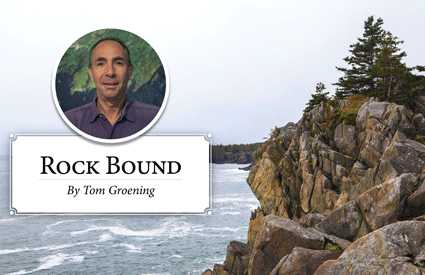
Assuming I have your attention, I am now going to ask you to look up and around the room in which you are sitting. What percentage of the things in the room were once aboard a ship? Thirty-five percent? Fifty percent? Seventy percent?
Experts put the answer at over 90 percent. Go beyond the furniture, light fixtures, carpet, and electronics and add the fuel that heats the room and the lumber and other materials that built it, and your’e well into the 90 percent range.
This is why the container ship stuck in the Suez Canal was such a big story. So much of what we consume has, at least for part of its journey, been carried on a ship. As Mainers, we tend to be oblivious to how big a role this kind of transportation plays in our economy. We shouldn’t be.
So much of what we consume has, at least for part of its journey, been carried on a ship.
And I count myself in the oblivious category. Driving from my home in Belfast to the office in Rockland, I often see ships making their way up Penobscot Bay, probably bound for the port at Searsport, but Bucksport and even Bangor have been destinations.
But what’s in them? Where did they begin their journey?
The state, back in the 1970s, wisely decided to focus its port investment funds in three areas: Eastport, Searsport, and Portland. Eastport, sadly, has lost its rail connection, a key component of a successful port. In Searsport, the state sought to develop a container port on Sears Island, but finally gave up that effort.
The Mack Point facility in Searsport offloads heating oil, gasoline, salt for roads, tapioca and clay slurry for paper mills, and other chemical products. Fuels also come into South Portland, and Portland actually has healthy export activity, thanks in part to the presence of Icelandic firm Eimskip, which works in ports throughout the world. Eastport ships out woodchips and imports fish.
Since all those goods in your room didn’t come in via Maine’s three ports, we must understand the ports at St. John, New Brunswick; Boston; Montreal; and New York as “our” ports, too.
When I was a kid, my family vacationed for a few summers at a campground on the St. Lawrence River in upstate New York. My father would take us out in his 14-foot aluminum boat, and my brothers and I thrilled to see the ships that would chug by us along the St. Lawrence Seaway, leaving or heading to the Midwest.
Those ships—which probably were 300-feet or so long—would be dwarfed by today’s tankers and container vessels. I’ve wondered how the numbers make sense; what must it cost to build a ship that size, and what must be charged to carry freight?
One part of the answer is something former Transportation Commissioner John Melrose told me years ago—shipping creates the smallest carbon footprint of all the major transport modes, and so the low-friction operation means relatively lower costs.
The Portland port has marketed its services by noting that for about the same $2,000 that it costs to ship a container on the back of a truck to the mid-Atlantic states, a ship can carry that container to northern Europe and reach markets with millions more people.
Maine is a full day closer to European ports than New York and that fact makes our ports valuable. As ships get bigger, we must keep up with dredging and other improvements, or Maine’s economy risks being seen as the hotdog stand on the end of a dead-end road.
Shipping also creates ancillary businesses like pilot and tug services, and those are no small nickel and dime activities.
Yes our three ports are industrial in nature, and yes they carry the potential for environmental catastrophe. But they also strike a blow against climate change. Maine must resist any impulse to marginalize our ports and shipping, even as we continue to fight to protect our clean waters and the high quality of our coastal life.
For more information about Maine’s shipping economy, see data in the Island Institute’s Waypoints publication.
Tom Groening is editor of The Working Waterfront.




